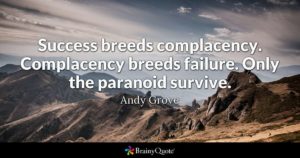
I think we’re at risk of losing our edge as a nation.
And that worries me. It worries me a lot.
Every day I read and hear about the dysfunction in our nation’s capital.
The hyper-partisanship.
The inability to seize opportunities, solve problems or to get things done.
The endless bickering and sniping at each other.
Climate change is real, but there’s a large swath of people who just won’t accept the science. So we nibble around the edges, endure catastrophic and costly weather “events” and seem immune to bad news such as a new report that says up to 1 million species of animals and plants are in danger of mass extinction. That’s not a typo…one million species the biggest “event” since the dinosaurs went bye bye.
And the list goes on.
Time Magazine reports that Russia is palling around with the world’s despots exporting trouble and trying desperately to hack into every institution the West values.
China is using its money to buy influence by financing infrastructure projects in other countries while working feverishly to take the lead in key emerging areas such as Artificial Intelligence and 5G wireless.
Meanwhile, our infrastructure is falling apart, we don’t have enough housing, our public schools struggle, we suffer from widespread opioid abuse and we can’t even pass a disaster relief bill to help people in the flood prone Midwest, wildfire scarred Northern California and hurricane ravaged Puerto Rico. The beat goes on, but you get the picture.
Sure, every other nation on Earth has its fair share of maladies but this is more about our inability to respond and collaborate than it is about the issues themselves. Truth is, if you are able to respond, work through problems and find common ground, you can solve just about anything or at least make things better.
But I see our nation’s leaders more focused on sticking it to each other than buckling down and working to create a better world for future generations. By the way, that’s what leaders do, focus on leaving a better world. So if you are failing the present and letting down the future you are not leading. You are laying an egg.
But this is a hyperlocal blog, focused on our community so how does this all relate?
Well, glad you asked.
Boca and Delray are two very successful communities—not trouble free, not perfect, not without challenges and real issues, but fairly successful nonetheless. But like America, if we rest on our laurels, we will be passed by. Maybe not today, maybe not tomorrow, but someday for sure.
The core question then is how to do we survive our success?
Atlantic Avenue is so popular that it’s literally bursting at the seams.
Now that’s a better problem to have than tumbleweeds on your Main Street, but it is an issue.
If I was still a policymaker (and thank goodness I’m retired) I would be worried about high rents on Atlantic fueled by sky high acquisition prices forcing establishments to sling high margin drinks to make ends meet. This leads to a Bourbon Street feel that some people like and others don’t care for.
Now I remain a fan of downtown Delray and take pride in our success, but I’d be concerned about those trends, competition from nearby cities and the need to spread the crowds to other parts of our downtown and make sure that the offerings appeal to a wider demographic.
I know far less about Boca, but I spend a lot of time in that city and I see traffic problems caused by sprawl and hear a lot of angst about the future.
The bottom line is that cities– and nations– no matter how successful can never rest.
Complacency is a killer.
A smug attitude will set you up to be knocked off your pedestal. You have to wake up a little scared every morning…especially when things are going well.
For so long, America led the world and we still do, but our future hegemony is not guaranteed. And the nitwits in D.C. and cable news pundits should be putting America before party loyalty…and that’s directed at both the left and the right.
Back here at home, we can’t assume that Delray will always be the reigning “hot spot” or that Boca will always be “all that” as they say.
Cities need constant renewal. They need vision. They need leadership and competent management and an active, engaged and dedicated citizenry.
No shortcuts.
And no exceptions.


